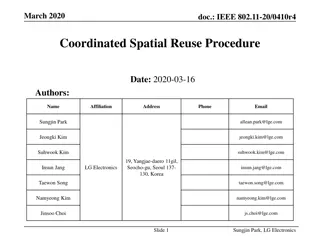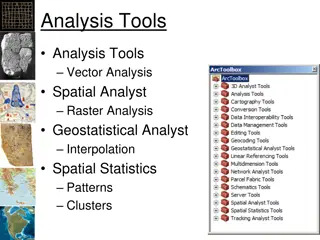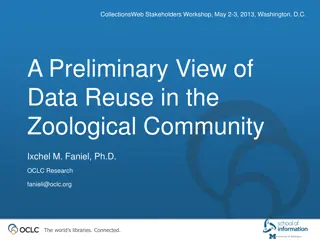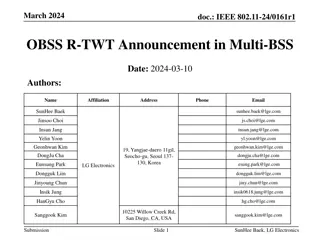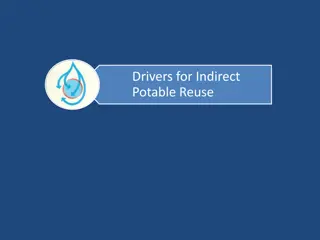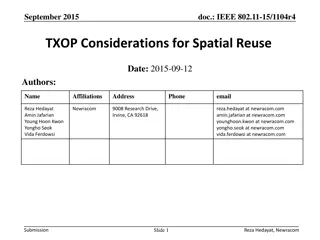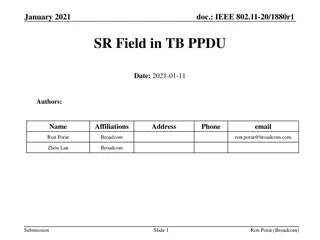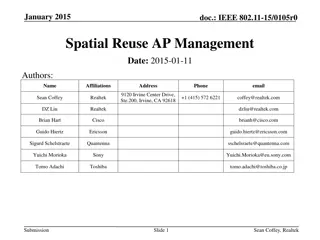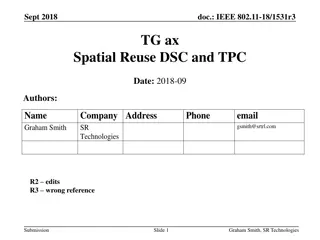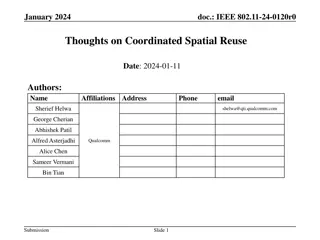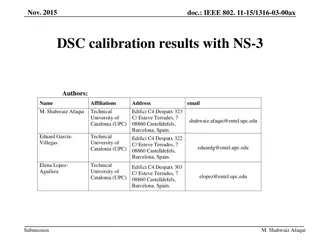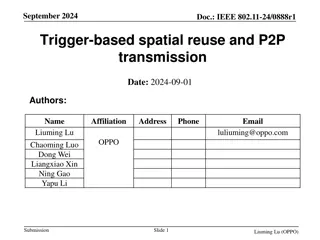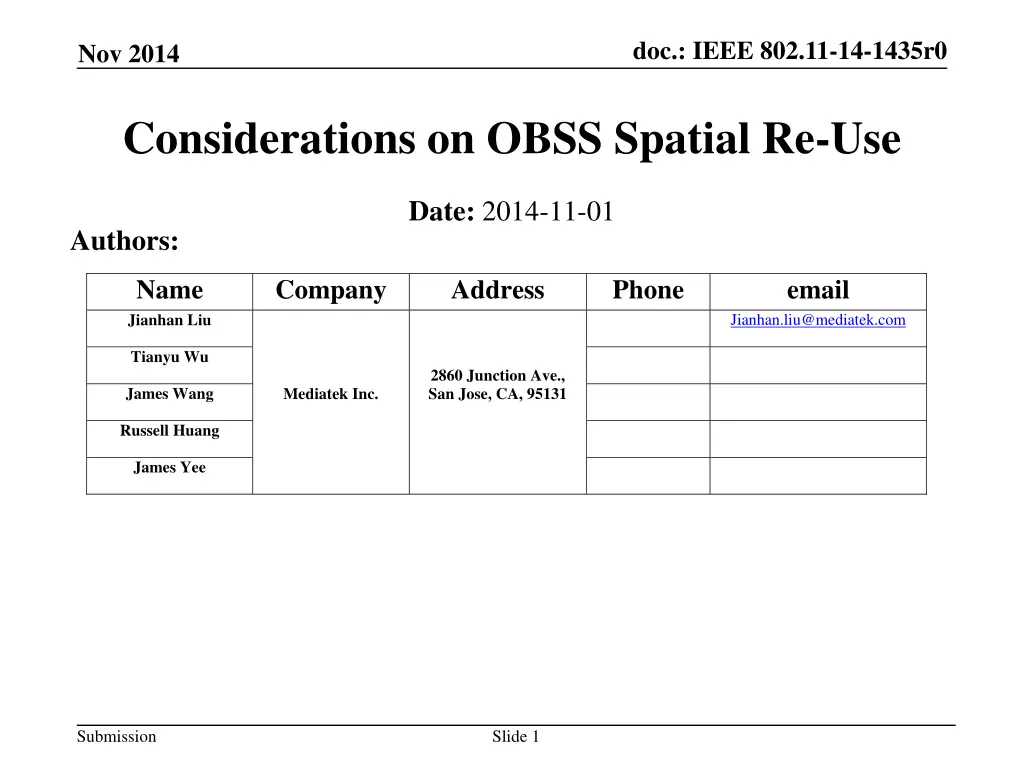
IEEE 802.11 Spatial Re-Use Considerations
Explore considerations and ideas for spatial re-use in IEEE 802.11 networks, addressing issues like OBSS, dynamic sensitivity control, CCA enhancement, and maximizing network throughput. Learn about spatial re-use metrics, adjustment of CCA levels, and introducing spatial re-use capability for enhanced network performance.
Download Presentation

Please find below an Image/Link to download the presentation.
The content on the website is provided AS IS for your information and personal use only. It may not be sold, licensed, or shared on other websites without obtaining consent from the author. If you encounter any issues during the download, it is possible that the publisher has removed the file from their server.
You are allowed to download the files provided on this website for personal or commercial use, subject to the condition that they are used lawfully. All files are the property of their respective owners.
The content on the website is provided AS IS for your information and personal use only. It may not be sold, licensed, or shared on other websites without obtaining consent from the author.
E N D
Presentation Transcript
doc.: IEEE 802.11-14-1435r0 Nov 2014 Considerations on OBSS Spatial Re-Use Date: 2014-11-01 Authors: Name Jianhan Liu Company Mediatek Inc. Address 2860 Junction Ave., San Jose, CA, 95131 Phone email Jianhan.liu@mediatek.com Tianyu Wu James Wang Russell Huang James Yee Submission Slide 1
doc.: IEEE 802.11-14-1435r0 Nov 2014 Ideas on Spatial Re-use Two metrics need to be considered when we deal with OBSS spatial reuse problem Average throughput per STA (overall network throughput) Throughput of the 5% lowest throughput STAs (edge STAs , legacy STAs, etc.) Dynamic Sensitivity Control [1] Problem: Reducing sensitivity hurts channel sensing of intra-BSS transmissions. Receiver should keep the highest sensitivity such that it can identify the ongoing transmissions coming from other BSSs or from its own BSS. Spatial re-use can only happen when the ongoing transmissions are from other BSSs. CCA enhancement Based on BSS color to differentiate the intra BSS and inter OBSS packets 1. Increase the CCA level by a fixed value [2-3] Pros: easy to implement; network throughput can be enhanced in dense scenarios shown by simulations 2. Dynamic CCA levels [4-6] Pros: self-optimization in different scenarios by adapting CCA levels Submission Slide 2
doc.: IEEE 802.11-14-1435r0 Nov 2014 About spatial reuse Typical understanding of spatial reuse For a device, space-reuse is related to adding one more spatial reuse link on top of ongoing links For a network, it is the number of concurrent links in a given area. Most of existing proposals focus on increasing the number of spatial reuse links in a given area. However, number of spatial reuse links is not equivalent to network throughput More spatial reused links with low MCS may lead to low system throughput than less spatial reused links with high MCSs. The goal shall be maximizing the network throughput Submission Slide 3
doc.: IEEE 802.11-14-1435r0 Nov 2014 Issues on Adjustment of CCA Levels Increasing the fixed CCA level Problem: STAs that only support lower MCS have the same channel accessing opportunity as STAs that support high MCSs. Network throughput is not maximized. Dynamic CCA ideas may hurt network throughput To gain more opportunities to transmit, every STA is inclined to use the highest CCA level allowed by reducing its MCS such that overall network throughput may decrease. In worst cases, most packets can be MCS0 modulated . The outcome of Dynamic CCA is every STA will use the highest CCA level that the lowest MCS can be used. Enhancing spatial reuse Should target to maximize network throughput instead of maximize number of concurrent transmissions. Just playing CCA levels can not optimize the network throughput. Submission Slide 4
doc.: IEEE 802.11-14-1435r0 Nov 2014 Introducing Spatial reuse capability BSS 1 BSS 2 No matter what CCA rules are used, STA_12 has larger spatial reuse capability Larger spatial reuse capability can be transferred to higher MCS or less interferences to OBSSs. No matter which option a STA chooses, the whole network throughput is enhanced Submission Slide 5
doc.: IEEE 802.11-14-1435r0 Nov 2014 Spatial reuse capability are dynamic BSS 0 BSS 0 Interference is dynamic, so does the spatial reuse capability for different STAs In the figure, STAs in the shaded areas have larger spatial reuse capability Enhanced CCA ideas just bring more STAs to contend for channel accesses but not address who has better chance to win the contention Submission Slide 6
doc.: IEEE 802.11-14-1435r0 Nov 2014 How to define Spatial reuse capability? Spatial reuse capability is a parameter that can be used to maximize network throughput. Spatial reuse capability can be a function of co-channel interference from OBSS CCI_OBSS The smaller the CCI_OBSS, the larger the Spatial reuse capability Spatial reuse capability can also be a function of co-channel interference from OBSS CCI_OBSS and path-loss between the STAs and its target destination PL The smaller the CCI_OBSS, the larger the Spatial reuse capability and the smaller the PL, the larger the Spatial reuse capability Maximizing network throughput by enhancing spatial reuse Network Throughput is a function of spatial reuse capability. The basic principle is to give the devices that can contribute more to the network throughput more opportunities to transmit. Submission Slide 7
doc.: IEEE 802.11-14-1435r0 Nov 2014 References [1] Dynamic Sensitivity Control Practical Usage , IEEE 802.11-14/0779r2. [2] Performance Gains from CCA Optimization , IEEE 802.11-14/0889r0 [3] Effect of CCA in residential scenario part II , IEEE 802.11-14/1199 [4] Impact of CCA adaptation on spatial reuse in dense residential scenario , IEEE 802.11-14/0861r0 [5] Increased Network Throughput with Channel Width Related CCA and Rules , IEEE 802.11-14/0880r1 [6] Adaptive CCA for 11ax , IEEE 802.11-14/1233r1 Submission Slide 8


